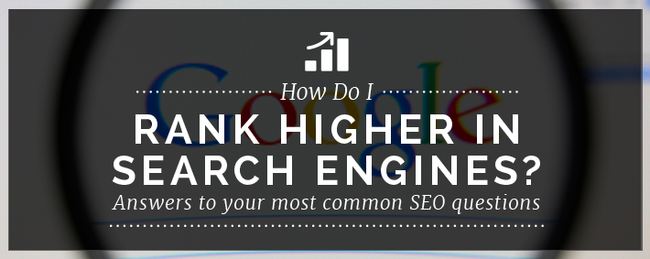 There's a book on the coffee table in my bedroom titled, "Why Do Men Have Nipples?: Hundreds of Questions You'd Only Ask a Doctor After Your Third Martini."
There's a book on the coffee table in my bedroom titled, "Why Do Men Have Nipples?: Hundreds of Questions You'd Only Ask a Doctor After Your Third Martini."
I can't quite remember where or how I acquired it to be honest, but I keep it out on my coffee table to remind myself to ask questions (even embarrassing ones) whenever I have them.
Quite honestly, I think the fear of asking a silly question is more detrimental to our professional growth than many of us are willing to acknowledge.
We consciously internalize this list of inquiries, that if answered, could help us arrive at new solutions or present us with untapped opportunities, all because we're afraid to admit that we don't, in fact, know everything.
So rather than wait for that third martini buzz to kick in, I decided to take it upon myself to serve up some answers to the "embarrassing" questions that many inbound marketers have in their queue.
1) What’s the significance of buyer personas?
Detailed buyer personas make up the secret sauce behind every targeted, personalized marketing strategy.
Essentially buyer personas serve as semi-fictional representations of your ideal prospect that are designed to help your team execute campaigns that lend themselves well to not just people, but the right people.
They help improve alignment across your entire company by explicitly spelling out the behaviors, goals, motivations, pain points, and demographics of the audience you are striving to reach.
Additionally, they provide a foundation and structure for carrying out all of your content creation efforts.
If you’re looking to attract and close valuable, qualified customers, you need to have well-defined buyer personas in place.
2) What should we be posting on social media?
Many businesses going inbound have little to no experience with social media.
In an effort to avoid the sound of virtual crickets every time you post, it’s important that you’re well-versed in the type of content your audience actually wants to engage with.
Remember that old print ad you were running? Content like that shouldn’t even come within a 10 foot radius of any of your social media accounts.
Rather than muck up your follower’s newsfeeds with a sales pitch, your focus should be on providing value and relevance above all else.
This type of engagement requires not only consistent posting, but also a strong focus on active listening.
Uncover what questions people are asking and share content that lends itself to those inquiries.
Also, don’t be afraid to reveal your human roots. People want to know that there is a living, breathing entity behind your handle, so work towards incorporating visuals, responding back to mentions, and reciprocating when others share your content.
3) Should I be A/B testing?
I know I implied that there's no such thing as a silly question, but if there were, this would be one of them.
The answer here is absolutely yes.
A/B testing is the best way to ensure that you are providing your visitors, leads, and customers with the most valuable and engaging experience possible. By determining what's proven to work and what falls short, you can eliminate ineffective elements and replace them with the ones you know will drive results.
If you're unsure what you should be A/B testing, consider the following suggestions:
- Headlines
- Calls-to-action
- Color
- Required form fields
- Form length
- Visuals
- Length of copy
If you're unsure of the value or A/B testing, check out the following cases:
- LKR Social Media saw a 24% increase in signups for their newsletter by testing a new version of their primary headline. (Source: Visual Web Optimizer)
- The Sims 3 was about to get 128% more visitors to register for games by testing an improved value proposition. (Source: KissMetrics)
- comScore saw a 69% increase in new leads after adding a customer logo alongside their testimonial. (Source: Optimizely)
4) What is "smarketing"?
For too long the relationship between sales and marketing was something like a sibling rivalry. The minute something went wrong with sales, marketing was quick to point the finger and vice versa.
Not only was this tug-of-war style relationship tiresome, but it was really unproductive.
Until one day, HubSpot's own Dan Tyre coined the term "smarketing", and a revolutionary concept was brought into being.
The term smarketing is refers to, well, exactly what you'd think it would - the alignment between sales and marketing teams.
Often times the two teams work out an SLA (service level agreement), in which they define and set measurable goals to ensure that both sides know what they are going to be held accountable for.
These goals should be re-evaluated regularly in order to identify and improve upon any weak areas that surface at the close of the month.
The purpose of this type of arrangement is to unite each team's efforts to strengthen the alignment around goals and personas in order to achieve greater results in terms of revenue.
5) What's the point of a meta description?
Each individual page on your site has its own unique meta description that looks like this:
This snippet of information that appears below your title on search engine results pages is responsible for quickly and concisely describe the purpose of the content to those searching.
Search engines results pages will only display the first 155 of your meta description so it's important to keep it under that number to ensure that people will click through to your website. Being mindful of the length will also help you to avoid any awkward sentence cut-offs that may take away from the description.
You'll notice that the words within the description that match the search query are bolded. This is a purposeful feature that helps searchers gauge the relevance of your content.
6) Where does a conversion path lead to?
Ideally a conversion path leads to a customer, but that's just the short of it.
The conversion process starts with a stranger. An anonymous website visitor who comes across an interesting content offer on your website. This visitor will then proceed to click the call-to-action for the offer which directs them to the corresponding landing page.
The landing page is where the magic happens (or so they say.) Once on this page, the visitor will be prompted to fill out a form to capture some of their contact information in exchange for the offer. Once they submit the form, they are directed to a thank you page where the actual offer lives.
So to break that down quite simply, the conversion path looks like this: Offer > Call-to-Action > Landing Page > Thank You Page
7) Should I put a call-to-action on every page?
The execution of any inbound marketing strategy relies heavily on the implementation of compelling calls-to-action.
When it comes to your seeing things through the perspective of your audience, it’s important to recognize their need for direction. The inclusion of a call-to-action on every page will help you to acknowledge this need and provide them with the desired next step.
It’s all about careful and calculated persuasion.
If you want them to download an ebook, create a call-to-action. If you want them to subscribe to your blog, create a call-to-action. If you want them to register for a webinar, yup, you guessed it..create a call-to-action.
If you’re worried about coming off as overbearing, be sure to ask yourself if the call-to-action you’re putting forth is aligned with the content on the page. As long as it’s relevant, it’s often welcomed by visitors who are looking for a quick word of direction.
8) I thought TOFU was a food, what's that all about?
You're right. Tofu is, in fact, a food. However, TOFU is 1 of 3 inedible acronyms used to reference the different stages of the sales funnel. Allow me to explain:
TOFU (Top of the Funnel)
At the top of the funnel, the goal is to attract a large audience of prospective leads by providing them with educational content that speaks to their pain points.
The types of content that works best at this stage of the funnel are introductory blog articles (list posts / how-tos), ebooks, checklists, and guides.
MOFU (Middle of the Funnel)
In the middle of the funnel, the goal is to begin to identify potential qualified leads. At this level, the leads in your funnel are going to have a variety of interests and needs, which makes nurturing them with content a bit trickier.
The types of content that works best at this stage of the funnel are case studies, webinars, whitepapers, and more advanced ebooks.
BOFU (Bottom of the Funnel)
Once the TOFU leads have been captured and warmed up with your MOFU content, it's time for them to reach the bottom of the funnel. This point in the process is best comparable to the homestretch.
At this point you’re going to rely less on content and more on engagement like free trials, assessments, and consultations. Anything to get the dialogue up and going.
9) What are No Index, No Follow tags, and why do I need them?
A no index, no follow tag is a snippet of code that represents where my coding ability begins and ends.
The code looks a little something like this: <meta name="robots" content="noindex, nofollow" />
Essentially the no index tag signals to Google that you do not want them to index the page, and the no follow tag lets them know not to follow the links on that page.
So what's it to you?
Well, the no index, no follow tag is the only thing that stands between your thank-you pages and search engine results page discovery.
In order to sustain your lead generating efforts, it's important that you protect your thank-you pages with a no index, no follow tag by placing it in the <head> section of your page's HTML. This small step will allow you to rest assure that visitors won't be able to access your lead generating offers without having to pass through the "gate" that visitors who come across the content via the corresponding landing page would.
10) How long will it take for me to see the ROI?
Upon committing to inbound marketing, it is important for marketers to recognize that results aren't going to surface immediately.
For some business getting started with inbound marketing means starting from scratch with a new website, blog, and social media accounts, and for others it means building up these resources that are already in place.
Creating and implementing the assets necessary to drive awareness to your website takes time. Things like blog posts and premium offers aren't going to write themselves, or promote themselves for that matter.
While timing is dependent on your individual business' situation, it usually takes around six months to begin creating and sharing content that then has to be indexed by search engines like Google in order to start generating traffic and leads.
With that being said, it's important for marketers to understand that inbound marketing is more of a long-term investment than it is an overnight sensation.
There’s no such thing…
Don’t be a “silly” question hoarder.
After reading this, there should be no debate over whether or not you should ask a question or carry on not knowing. In fact, if you choose to remain in the dark, you’re the silly one and I am embarrassed for you.
It’s important to remember that for anyone getting their feet wet with inbound marketing, there’s going to be an inevitable learning curve. Don’t allow the fear of asking questions hinder your ability to start seeing results sooner rather than later.
With that being said, what embarrassing inbound marketing questions do you still have? I’d love to answer anything I can in the comments below.
Originally published Jun 16, 2014 2:00:00 PM, updated January 18 2023
Topics:
Inbound MarketingDon't forget to share this post!
Related Articles
Expand Offer

